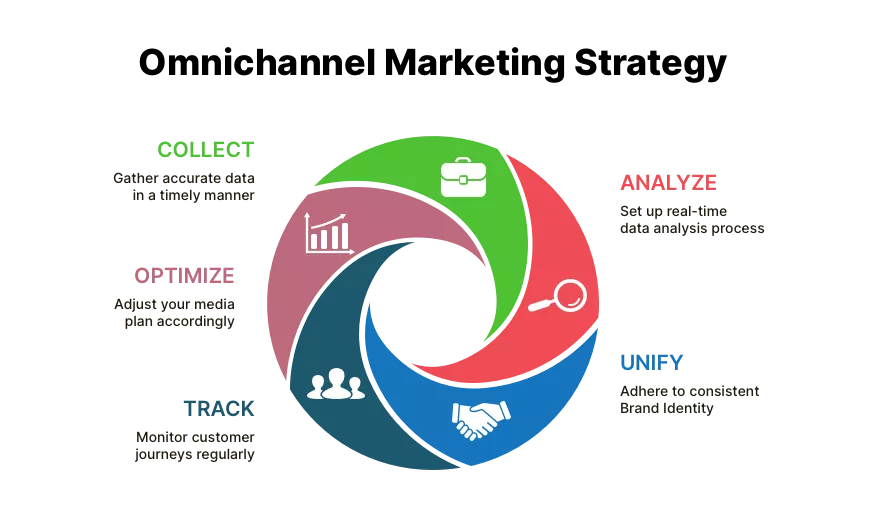Omnichannel marketing is a strategy employed by many large organizations around the world, although it is not a term you may frequently encounter. Think of it as a way of surrounding your potential customers with easy, seamless ways to interact with your brand. Let’s take a deep dive!
The Word “Omnichannel”: Where It Comes From
Omnichannel marketing is all about connecting the dots between the various ways people find your company or brand. This includes:
The goal is a smooth, satisfying experience for the customer no matter how they interact with you – being able to seamlessly switch between channels. An example of this would be a customer placing an order online for pickup in person – if a company’s omnichannel strategies are solid, this ought to be a straightforward and seamless experience for the customer.
Omnichannel marketing is becoming more and more commonplace and is no longer limited to retail. Such diverse industries as healthcare, finance, and tech are all making use of it.
So, let’s explore how it works and how you can make it work for you.
Think of omnichannel marketing as a customer-first strategy. Modern consumers have endless options when it comes to interacting with their favorite brands. They have a wealth of alternate brands if they’re not happy with their current product or service.
This means you need:
Yes, omnichannel marketing can be complex, but the rewards are huge!
Here’s why it’s worth the effort:
It’s time for a mindset shift to focus fully on the customer (rather than the channel).
Here are the key steps:

Let’s take a look at some companies that have already been making the best use of an omnichannel approach.
Clothing giant Nordstrom seamlessly blends online and in-store experiences, like their partnership with Pinterest for in-store upsells. Smart and successful!
Shoppers in brick-and-mortar Nordstrom stores can scan a Pincode, which takes the user to a Pinterest page with Nordstrom bargains. In addition to being a novel wrinkle in the offline shopping experience, the feature has driven sales via word-of-mouth and subtle suggestive upselling.
The brand has turned its hand to YouTube videos that offer solid, constructive advice and conclude with a perfectly pitched call to action. Other companies would do well to learn from this unique and multifaceted marketing strategy.
Similar to Nordstrom, Timberland is integrating its on- and offline experiences by having customers make use of apps in-store to drive customer engagement. The in-store ‘Touchwalls’, flashing up personalized information regarding various kinds of shoes and sneakers.
Customers can use these walls to add footwear to their wishlist or cart, and can then purchase the footwear in-store if they wish. Timberland is also able to use the data collected to recommend more obscure makes of footwear, which leads to an increase in sales for their lesser-purchased stock.
As many focus on the apps, Starbucks wins by making it super easy to top up your rewards card from your computer or device and skip the morning lines by ordering via the app. Consumer convenience is prioritized.
They excel at personalization and convenience across every channel imaginable. That focus on the customer is why they’re on top. Amazon’s answer to omnichannel marketing is blinding in both its simplicity and its brilliance: Amazon Prime.
There are tons of reasons why customers sign up for Amazon Prime, making it a great example of the omnichannel approach. Initially, Prime was like a ‘discount card’ for fast, free shipping – a huge reason people subscribe. Amazon often offers trial memberships to hook new customers, and the convenience quickly outweighs the monthly cost.
But to keep people hooked even further, Amazon keeps adding benefits. Here are a few of the biggest draws:
Why does Amazon offer so much? Simple: it gathers all your data in one place. This fuels their powerful recommendation engine and makes Prime Video just as easy to use as Prime Delivery. In short, they’ve created a seamless experience across channels that keeps customers spending and coming back for more.
The drugstore giant Walgreens has its own app that makes refilling prescriptions super easy. But they didn’t stop there! They added health-tracking features (like those on your Fitbit or Apple Watch) to boost engagement with promotions, contests, and leaderboards. This clever mix of pharmacy and health app features increases brand awareness in a way that feels helpful, not pushy – a great way to boost customer loyalty and sales.
Omnichannel is the future of marketing, and these trends are already shaping how successful businesses operate. If you want to maximize your ROI, pay attention to:
Brands like Starbucks, Nordstrom, and Timberland prove there’s no longer a purely offline experience. Customers want the convenience of ordering online and picking up in-store. Make this process easy, and they’ll choose your business.
As Amazon shows, brand consistency is key. Customers want the same great experience whether they’re on your app, website, or in your store. Provide that, and you’ll win.
Plain and simple, customers who engage with you on multiple channels spend 3-4 times more than those on a single channel. Give them options!
You think someone buys some things on their phone and others on their TV? Think again!
They may start a purchase on their phone and finish on another device. Important points:
This is how modern companies win. Meet customers where they are, on their terms. Make it easy to interact, and build that recognizable, consistent brand. Do this right, and you’ll see greater loyalty, sales, and long-term success.

Email subscription is available ONLY TODAY (oh, okay, and tomorrow).
Surely, we respect your inbox! Unsubscription works every day.

We’d love to tailor your experience — which of these best describes you?